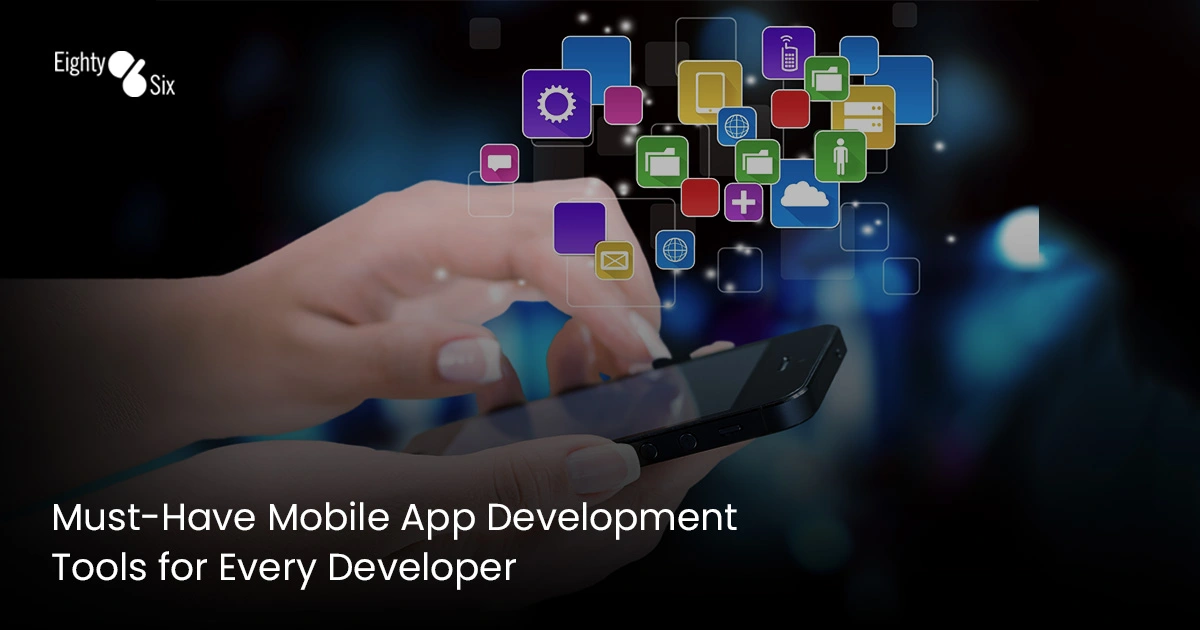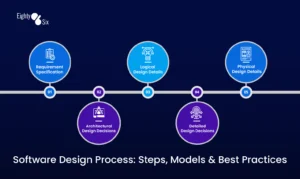Must-Have 25 Mobile App Development Tools for Every Developer

Table of contents
In 2025, mobile app development continues to evolve with groundbreaking tools designed to simplify workflows, speed up development, ensure better performance, and deliver exceptional user experiences. Whether you’re building for Android, iOS, or cross-platform ecosystems, choosing the right development tool can make all the difference.
Below is a comprehensive guide to the Top 25 Mobile App Development Tools for 2025 and Beyond, complete with detailed overviews to help you select the best tools for your app development journey.
| Tool | Type | Platforms | Code/No-Code | Best For |
|---|---|---|---|---|
| Flutter | Open-source framework | Android, iOS, Web, Desktop | Code | High-performance cross-platform apps |
| React Native | Open-source framework | Android, iOS | Code | Fast development with reusable components |
| Xamarin | Framework + SDK | Android, iOS, Windows | Code | C# developers and enterprises |
| Android Studio | IDE + SDK | Android | Code | Professional Android apps |
| Xcode | IDE + SDK | iOS, macOS | Code | Native Apple apps |
| Ionic | Framework + Toolkit | Android, iOS, Web | Code | PWAs and hybrid apps |
| Apache Cordova | Framework | Android, iOS | Code | Lightweight hybrid apps |
| Unity | Game engine | Android, iOS, PC, AR/VR | Code | Games and immersive apps |
| Firebase | BaaS + Tools | All | Backend | Real-time backend & analytics |
| Backendless | Visual backend builder | All | Backend | No-code backend APIs |
| Swiftic | App builder | iOS | No-Code | Small business apps |
| BuildFire | Builder + platform | Android, iOS | No-Code | Service and inventory apps |
| Thunkable | No-code builder | Android, iOS | No-Code | Beginners & education apps |
| Appgyver | Visual builder | Android, iOS, Web | No-Code | MVPs and fast prototyping |
| Appy Pie | Builder + services | Android, iOS, PWA | No-Code | Entrepreneurs and SMBs |
| Adalo | Visual builder | Android, iOS | No-Code | MVPs with backend logic |
| AppSheet | Google’s no-code | Android, iOS | No-Code | Data-driven internal apps |
| Glide | Sheet-based builder | Android, iOS, Web | No-Code | Internal tools and dashboards |
| Mendix | Enterprise low-code | All | Low-Code | AI-powered enterprise apps |
| OutSystems | Enterprise-grade platform | All | Low-Code | Regulated industry apps |
| Zoho Creator | Business tool builder | All | Low-Code | SMB workflows and automation |
| Alpha Anywhere | Offline-first dev | Android, iOS, Web | Low-Code | Field service & data entry |
| AppInstitute | Builder for SMBs | Android, iOS | No-Code | Local businesses |
| Appian | Workflow platform | All | Low-Code | Enterprises & process automation |
| GoodBarber | PWA & native builder | Android, iOS | No-Code | eCommerce, content apps |
1. Flutter
Developed by Google, Flutter is a powerful open-source UI toolkit that enables developers to build natively compiled applications for mobile (iOS & Android), web, and desktop (Windows, macOS, Linux) from a single codebase. Flutter uses Dart, a modern and efficient programming language also created by Google, designed for fast development and high-performance apps.
Key Features:
- Hot Reload: One of Flutter’s standout features, Hot Reload allows developers to see code changes in real time without restarting the application. This drastically speeds up development and testing cycles.
- Rich Widget Library: Flutter offers a comprehensive set of pre-built and customizable widgets that replicate the native look and feel of Android and iOS. Everything in Flutter is a widget, giving developers full control over layout and design.
- Excellent Performance: Flutter apps are compiled directly to native ARM code and use Skia, a high-performance 2D rendering engine, ensuring smooth animations and fast user interactions.
Best For:
Developers and teams aim to build high-quality cross-platform applications with beautiful, custom UIs and native-like performance, all while maximizing code reuse and minimizing development time.
2. React Native
React Native, developed by Meta (formerly Facebook), is a popular open-source framework that enables developers to build cross-platform mobile applications using JavaScript and React. It allows near-native performance by bridging JavaScript with native components, making it ideal for building high-performance apps without writing separate codebases for Android and iOS.
Key Features:
- Code Reusability: Share up to 90% of the codebase across iOS and Android platforms.
- Native Modules: Easily access device features (camera, GPS, etc.) by bridging JavaScript with native code.
- Hot Reloading: Update code and see changes instantly without restarting the app.
- Vibrant Ecosystem: Extensive library support and an active community for quick troubleshooting and development.
Best For:
JavaScript and React developers who want to build high-quality, cross-platform apps with a native look and feel.
3. Xcode
Xcode is Apple’s official Integrated Development Environment (IDE) for creating applications for iOS, macOS, watchOS, and tvOS. It supports both Swift and Objective-C, and offers a comprehensive suite of tools to design, develop, test, and deploy apps on Apple platforms.
Key Features:
- Interface Builder: Visually design UIs with drag-and-drop components.
- Simulator: Test apps across various Apple devices and screen sizes.
- Instruments Tool: Profile, debug, and optimize app performance efficiently.
Best For:
Professional developers focused on building native iOS and macOS apps with full access to Apple’s ecosystem.
4. Android Studio
Android Studio, backed by Google and built on IntelliJ IDEA, is the official IDE for Android app development. It offers robust tools and a developer-friendly environment for building, testing, and optimizing Android applications.
Key Features:
- Smart Code Editor: Context-aware code completion and real-time error checking.
- Advanced Emulator: Simulate multiple Android devices and OS versions.
- Layout Editor: Drag-and-drop interface design with live previews.
- Multi-language Support: Write Android apps using Java, Kotlin, or C++.
Best For:
Developers building native Android applications who need deep customization and integration with the Android SDK.
5. SwiftUI
SwiftUI is Apple’s modern UI framework that enables developers to build user interfaces for iOS, macOS, watchOS, and tvOS using the Swift programming language. It simplifies development through declarative syntax and seamless integration with Xcode.
Key Features:
- Declarative Syntax: Define complex UIs with simple, readable code.
- Live Preview in Xcode: Instantly visualize changes as you code.
- Cross-Platform Support: Build apps across Apple’s entire ecosystem from a single codebase.
Best For:
Swift developers focused on building native Apple platform apps with modern UI techniques.
6. Kotlin Multiplatform Mobile (KMM)
Kotlin Multiplatform Mobile (KMM) by JetBrains allows sharing business logic between iOS and Android apps while retaining native UI experiences. It enables teams to write platform-independent code in Kotlin and reuse it across projects.
Key Features:
- Shared Business Logic: Reuse core code across mobile platforms.
- Access to Native APIs: Directly call platform-specific APIs using Kotlin.
- Tooling by JetBrains: Seamless integration with Android Studio and other JetBrains tools.
Best For:
Kotlin developers and teams aiming for code reuse in cross-platform apps without compromising native UI.
7. Unity
Originally built as a game development engine, Unity has expanded to support AR/VR, real-time 3D applications, and interactive mobile apps across multiple platforms.
Key Features:
- Advanced Graphics Engine: Build immersive experiences with physics, animation, and lighting.
- Cross-Platform Deployment: Publish to iOS, Android, consoles, desktop, and more.
- Real-Time Rendering: Ideal for games and simulations requiring high responsiveness.
Best For:
Game developers and creators building AR/VR experiences or real-time 3D apps across devices.
8. Apache Cordova (PhoneGap)
Apache Cordova (formerly PhoneGap) enables developers to build cross-platform mobile apps using standard web technologies like HTML, CSS, and JavaScript. It wraps web apps in a native container to access device-level APIs.
Key Features:
- Plugin Architecture: Extend functionality with native device features.
- Device API Access: Tap into camera, GPS, notifications, and more.
- Cross-Platform Output: Write once, deploy on iOS and Android.
Best For:
Web developers looking to leverage existing skills for mobile app development.
9. Ionic Framework
Ionic is a popular hybrid mobile app framework that combines web technologies with native functionality through Capacitor or Cordova. Built primarily with Angular, it also supports React, Vue, and Vanilla JavaScript.
Key Features:
- Web-based UI Components: Mimic native app styles using HTML/CSS.
- Capacitor Integration: Access native SDKs and APIs with modern tooling.
- Framework Agnostic: Compatible with Angular, React, and Vue.
Best For:
Front-end web developers building progressive and hybrid mobile apps with familiar web stacks.
10. Sencha Ext JS
Sencha Ext JS is a powerful JavaScript framework designed for building data-intensive, cross-platform mobile and web applications, especially suited for enterprise use.
Key Features:
- Rich UI Widgets: Over 140 customizable UI components including grids, charts, and forms.
- MVVM Architecture: Supports clean separation of logic, data, and UI.
- Code Optimization Tools: Built-in tools for app packaging, minification, and performance tuning.
Best For:
Enterprise-grade apps require complex data handling and performance optimization.
Launch Faster with the Right Mobile App Stack
Don’t waste time juggling tools — build smart from day one. At weare86.com, we help founders and brands choose the ideal tech stack for MVPs, enterprise apps, or next-gen solutions.
11. PhoneGap Build
PhoneGap Build is Adobe’s cloud-based build service for Apache Cordova, enabling mobile app development without native SDK setup.
Key Features:
- Cloud-Based Builds: Compile apps online with no local environment required.
- Simple Deployment: Upload your code and get instant installable builds.
- Web Tech Stack: Uses HTML, CSS, and JavaScript for app development.
Best For:
Web developers creating simple mobile apps without heavy native integration.
12. Appgyver (Now SAP Build Apps)
Appgyver, now part of SAP as SAP Build Apps, is a no-code development platform for building mobile, web, and desktop apps visually.
Key Features:
- Drag-and-Drop Builder: Create UIs without writing code.
- Logic Flows: Design application logic visually.
- Backend Integration: Connect to REST APIs and databases easily.
Best For:
Non-developers, startups, and teams building MVPs and internal tools quickly.
13. OutSystems
OutSystems is a leading low-code platform focused on delivering enterprise-grade applications with full-stack capabilities.
Key Features:
- Visual IDE: Build UIs and logic with a drag-and-drop interface.
- Full-Stack Support: Develop front-end and back-end with integrations and automation.
- AI-Assisted Development: Speed up app building with intelligent recommendations.
Best For:
Enterprises needing scalable, complex apps with rapid development cycles.
14. BuildFire
BuildFire is a no-code app builder tailored for creating business, content, and eCommerce apps without technical expertise.
Key Features:
- Intuitive Builder: Easy drag-and-drop interface for app creation.
- Pre-made Templates: Customize industry-specific templates.
- CRM & eCommerce Integrations: Built-in plugins for Shopify, HubSpot, etc.
Best For:
Businesses, marketers, and content creators building feature-rich mobile apps.
15. Thunkable
Thunkable is a drag-and-drop app builder that enables rapid prototyping and deployment for mobile platforms.
Key Features:
- Component-Based UI Design: Assemble apps with reusable components.
- Cross-Platform Output: Publish to iOS and Android from one project.
- Custom Logic: Integrate APIs and create custom workflows visually.
Best For:
Students, educators, and creators developing learning tools or app prototypes.
16. Microsoft Power Apps
Part of Microsoft’s Power Platform, Power Apps enables low-code app development with native integration into the Microsoft ecosystem.
Key Features:
- Microsoft 365 & Dynamics Integration: Seamless connection to Microsoft tools.
- Pre-built Connectors: Connect to hundreds of services and databases.
- AI Builder: Add predictive capabilities using Microsoft AI.
Best For:
Organizations using Microsoft services for internal business app development.
17. Appian
Appian is an enterprise-focused low-code automation platform for building apps that streamline business processes.
Key Features:
- Workflow Automation: Design end-to-end process flows visually.
- Real-time Insights: Dashboards and analytics for business operations.
- Secure Cloud Deployment: Scalable infrastructure for sensitive data.
Best For:
Large businesses focused on process automation and digital transformation.
18. Zoho Creator
Zoho Creator is a low-code application builder designed for businesses to quickly develop custom apps.
Key Features:
- Form and Report Builders: Easily collect and display data.
- Deluge Script Support: Add advanced logic and automations.
- Zoho Suite Integration: Seamless connection with Zoho CRM, Mail, etc.
Best For:
Small to mid-sized businesses building internal apps or automation tools.
19. Codename One
Codename One is a Java-based cross-platform framework that allows you to build native mobile apps using a single codebase.
Key Features:
- Truly Native Output: Compiles Java to native iOS and Android apps.
- Cloud-Based Builds: Deploy apps to multiple platforms via the cloud.
- Swing-like UI: Easy transition for Java desktop developers.
Best For:
Java developers building high-performance mobile apps across platforms.
20. JHipster Mobile
JHipster Mobile extends the JHipster development stack to support mobile app creation using Ionic and Cordova.
Key Features:
- Full-Stack Generation: Backend (Spring Boot) + Frontend (Ionic) setup.
- Microservices Support: Ideal for distributed enterprise architecture.
- OAuth & JWT: Built-in security features for authentication.
Best For:
Enterprise teams looking to build full-stack mobile apps with modern tech stacks.
21. Firebase
Firebase, by Google, is a Backend-as-a-Service (BaaS) platform offering tools for building and scaling mobile/web applications.
Key Features:
- Realtime Database & Firestore: Sync data instantly across users.
- Authentication & Hosting: Secure login and easy app deployment.
- Cloud Messaging & Functions: Trigger serverless logic and send notifications.
Best For:
Developers need real-time features and backend tools without managing infrastructure.
22. Appcelerator Titanium
Appcelerator Titanium is a JavaScript-based framework that enables native mobile app development across platforms.
Key Features:
- Access to Native APIs: Build apps with native UI and performance.
- Alloy MVC Framework: Structured development with clean code separation.
- Real-time Analytics: Monitor app performance and usage metrics.
Best For:
JavaScript developers building high-performance, native-like mobile apps.
23. NativeScript
NativeScript is an open-source framework that allows building native mobile apps using JavaScript, TypeScript, Angular, Vue, or Svelte.
Key Features:
- Direct Native API Access: No WebView; direct interaction with native layers.
- Support for Multiple Frameworks: Flexible tech stack options.
- Rich Plugin Ecosystem: Extend apps with device-level integrations.
Best For:
JS/TS developers want full control and native app performance.
24. Corona SDK (Solar2D)
Corona SDK, now rebranded as Solar2D, is a lightweight framework focused on building 2D mobile games and casual apps.
Key Features:
- Lua Scripting Language: Simple, fast, and beginner-friendly.
- Rapid Prototyping: Fast development cycle with instant testing.
- Plugin Marketplace: Easily integrate ads, IAPs, and analytics.
Best For:
Indie game developers and hobbyists building 2D games or interactive apps.
25. Backendless
Backendless is a full-featured mobile backend-as-a-service (mBaaS) platform offering tools for serverless hosting, data management, and user services.
Key Features:
- Real-time Data Sync: Keep client apps updated with live data changes.
- API Generation & Codeless Logic: Auto-generate APIs and use visual logic builders.
- User Management & Push Notifications: Built-in features for auth and engagement.
Best For:
Developers seek a robust backend without managing servers or infrastructure.
Conclusion
Selecting the ideal mobile app development tool in 2025 depends on your unique goals—whether it’s your technical expertise, project size, preferred platforms, or launch timeline. From low-code platforms to full-scale native SDKs, there’s a tailored solution for every mobile app vision.
Use this guide as a reliable reference to evaluate, compare, and choose the right development stack for your next project.
At 86 Agency, we specialize in turning app ideas into powerful digital products. Need help selecting the right tech stack or building your app from scratch? Contact us—our team is ready to help you succeed.
FAQs
1. What is the best no-code or low-code platform for non-developers to build mobile apps?
Appgyver (SAP Build Apps), BuildFire, and Thunkable are excellent no-code platforms for non-developers. They offer drag-and-drop UI builders, logic flows, and easy integrations — ideal for building MVPs or internal business apps without writing code.
2. Which tool should I use for enterprise-level app development?
OutSystems, Appian, and Sencha Ext JS are designed for enterprise use. They offer advanced features like workflow automation, real-time data handling, and secure cloud deployments, making them ideal for large-scale and data-intensive applications.
3. What’s the difference between Firebase and Backendless as BaaS platforms?
Firebase, by Google, excels in real-time sync, hosting, analytics, and push notifications — great for rapid backend integration. Backendless offers more customization with codeless logic builders, user management, and data sync — ideal for developers who want more control without managing servers.
4. Can I build cross-platform apps using JavaScript?
Yes. Tools like React Native, Apache Cordova, Ionic, Appcelerator Titanium, and NativeScript allow you to build cross-platform apps using JavaScript or TypeScript, with varying levels of native performance and control.
5. Is PhoneGap still a good option for mobile app development?
No. PhoneGap Build was discontinued by Adobe in 2020. Developers should use modern alternatives like Apache Cordova, Ionic + Capacitor, or React Native for building hybrid or native apps.
6. Which platform is best for creating 2D games or AR/VR apps?
Unity is the best option for developing 2D/3D games and AR/VR apps, thanks to its real-time rendering, physics engine, and support for cross-platform deployment.
7. What tools support drag-and-drop visual app development?
Platforms like Appgyver, BuildFire, Thunkable, Microsoft Power Apps, and Zoho Creator offer intuitive drag-and-drop builders, making them ideal for non-coders and rapid app prototyping.
8. Which development tools support native performance without using WebViews?
React Native, NativeScript, Codename One, and Appcelerator Titanium provide native UI rendering and performance, unlike hybrid frameworks that rely on WebView (e.g., Cordova or Ionic).
Struggling to Pick the Right Mobile App Framework?
Whether it’s Flutter, React Native, or something AI-powered — we help startups and enterprises build apps that actually scale. Talk to experts at weare86.com and get a custom roadmap today.



